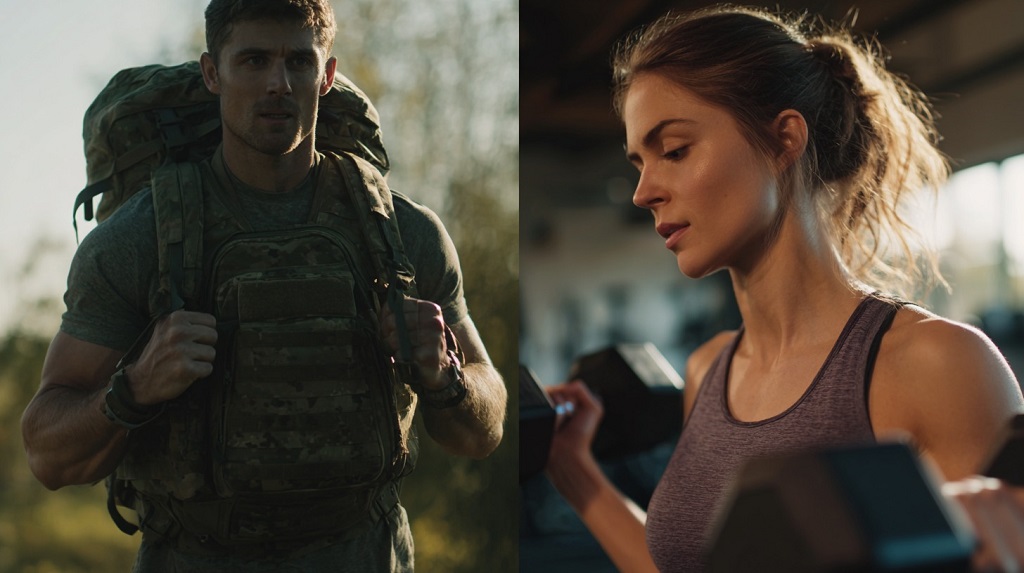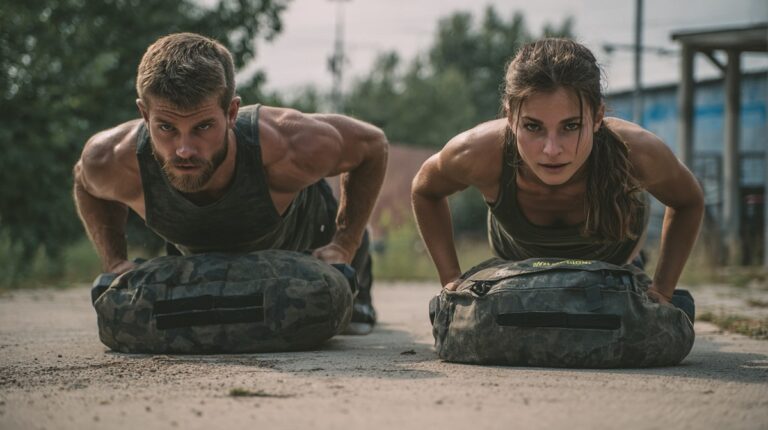Most people imagine military workouts as endless push-ups and punishing runs. The real difference runs much deeper. Military training and civilian fitness do not just operate at different intensities; they serve completely different purposes.
The military builds combat readiness and stress resilience, while civilian fitness focuses on health, functionality, and longevity. Those contrasting missions shape every element: structure, volume, load, environment, and mindset.
Here’s a complete breakdown of what separates the two systems and what practical insights civilians can safely take from the military model.
Key Highlights
- Military workouts focus on combat readiness, stress resilience, and discipline, while civilian fitness aims at long-term health and functionality.
- Military training involves higher intensity, heavier loads, strict testing, and group accountability.
- Civilian workouts prioritize safety, recovery, and personal flexibility with lower injury risk.
- Civilians can adapt military principles safely by training functionally, using measurable goals, and managing recovery.
What Regular Fitness Programs Aim For

Civilian fitness programs exist to promote health, prevent disease, and improve quality of life. They are guided by public health organizations like the World Health Organization (WHO), Centers for Disease Control and Prevention (CDC), and the American College of Sports Medicine (ACSM).
The general recommendations are clear:
- 150 to 300 minutes per week of moderate aerobic activity, or
- 75 to 150 minutes of vigorous activity, or
- A combination of both
Plus, adults should include muscle-strengthening exercises for all major muscle groups at least twice a week.
The goals reflect population-wide priorities:
- Lower the risk of cardiovascular disease and diabetes
- Support weight management
- Improve mood and sleep
- Maintain independence and daily function
Most civilian programs fit around busy schedules. Sessions run 30 to 60 minutes, three to five times a week, with flexibility to skip or adjust. Common approaches include:
- Gym workouts using machines or free weights
- Group classes like spin, yoga, or circuit training
- Running or cycling plans aimed at races or general fitness
- Personal training focused on aesthetics or mobility
The core idea is sustainability, not survival.
What Military Workouts Are Designed For

Military training has one goal: to create soldiers capable of performing under physical and psychological stress. Every movement, repetition, and drill ties directly to battlefield requirements.
According to the U.S. Army’s FM 7-22 Holistic Health and Fitness, the principle is simple: train as you will fight. Soldiers must develop endurance, strength, power, agility, and resilience, physical and mental, to handle combat situations.
Typical military demands include:
- Carrying heavy loads (gear, armor, ammunition) across rough terrain
- Sprinting, diving for cover, and maneuvering under fatigue
- Dragging or lifting injured teammates
- Working with limited food, sleep, and comfort
- Staying alert and coordinated under threat
The system trains the whole person: body, discipline, and mental fortitude.
Structure of Military Training
Basic Combat Training (BCT) in the U.S. Army lasts about 10 weeks, followed by job-specific instruction. During this period, recruits experience an intense mix of physical training, weapon handling, obstacle courses, and field exercises.
Physical Training (PT) usually happens early each morning and includes:
- Daily or near-daily sessions
- Leadership by noncommissioned officers (NCOs)
- Drills built around precision, progression, and integration
Beyond morning PT, recruits perform long field exercises, ruck marches, and combat simulations, often carrying heavy loads. The accumulated workload easily exceeds anything found in civilian gyms.
Fitness Tests
Most civilians never face mandatory physical testing. Soldiers, on the other hand, live and advance by measurable standards.
Military Fitness Tests
The Army Combat Fitness Test (ACFT), being phased into the new Army Fitness Test (AFT) by 2025, evaluates multiple capacities, according to RAND Corporation:
| Event | Purpose |
| 3 Rep Max Deadlift | Measures strength |
| Hand Release Push Up | Upper body endurance |
| Sprint-Drag-Carry | Anaerobic power and agility |
| Plank Hold | Core endurance |
| Two Mile Run | Aerobic capacity |
Combat-related roles use sex-neutral standards. Everyone in those fields must meet the same physical benchmarks.
Other militaries apply similar systems, especially elite units that run up to 50 miles per week during prep phases.
Civilian Benchmarks
Civilians measure success by effort and participation, not pass/fail metrics. Meeting WHO or CDC guidelines counts as success. There are no consequences for failing a workout or missing a week, just a gradual loss of fitness benefits.
Gyms do not remove clients for missing classes. In contrast, a soldier who repeatedly fails fitness tests can lose promotion eligibility or face reassignment.
Military vs Regular Fitness

| Aspect | Military Workouts | Regular Fitness Programs |
| Primary goal | Combat readiness and job performance under stress | Long term health, body composition, and general fitness |
| Weekly frequency | 5–6 structured PT sessions + field work | 3–5 sessions of 30–60 minutes |
| Load and intensity | High load, high impact, functional movement | Controlled intensity, individual comfort |
| Environment | Outdoor, unpredictable, harsh conditions | Indoor, stable, controlled spaces |
| Consequences | Professional and career outcomes | Personal satisfaction or appearance goals |
1. Goals and Philosophy
Military
Military programs are tied directly to operational performance. Physical fitness is a combat multiplier.
Soldiers must perform critical tasks while under duress: carrying equipment, lifting injured comrades, or scaling obstacles while fatigued.
The doctrine views fitness as discipline in motion. Shared hardship builds cohesion, trust, and identity across units.
Civilian
Civilian programs center on health and self-improvement. Goals vary widely:
- Losing weight
- Building muscle
- Completing a 10K
- Managing stress
They adapt to personal schedules and preferences. If something feels too demanding, people change programs or trainers. The approach is individual and self-paced.
2. Training Volume and Frequency

Most adults are advised to get around 150 minutes of moderate activity per week. Many fall short of even that. Soldiers, however, often exceed that figure in a single day.
Military PT runs 45 to 90 minutes several times a week, plus field exercises and marches that add hours of movement. During preparation for special operations, trainees might cover 40 to 50 miles per week of running alone, plus additional load-bearing work.
For context, that’s the workload of serious endurance athletes, not average gym-goers.
3. Intensity, Load, and Movement Types
Military workouts are functional and tactical. They simulate the movement patterns and physical stress of combat.
Common elements include:
- Sprints and change of direction drills
- Carries with sandbags, logs, or stretchers
- Crawling, climbing, and jumping under fatigue
- Lifting awkward objects rather than gym-standard weights
Also, many advanced trainees even use a 5.11 plate carrier during workouts to simulate the extra load soldiers carry in combat training.
It’s important to note that environmental stress adds another layer. Workouts might happen in heat, rain, snow, or mud. Surfaces are uneven. Gear adds weight and restricts mobility. Fatigue compounds quickly.
In contrast, civilian workouts favor stability and control:
- Machines or barbells in safe ranges of motion
- Climate-controlled gyms
- Predictable routines like cardio intervals or strength circuits
The intensity is adaptable and usually scaled for comfort or safety.
4. Testing, Standards, and Career Impact

Military fitness is quantifiable and tied to accountability. The AFT measures five components that reflect operational needs, not gym culture. A failing score can block advancement or lead to retraining.
Civilians, however, operate on personal accountability. The only “penalty” for skipping workouts is slower progress. There is no formal testing system outside of sports or specific certifications.
That difference changes motivation. Soldiers train to avoid failure and maintain readiness. Civilians train by choice, usually driven by personal satisfaction or appearance goals.
5. Injury Risk and Recovery Culture
Military training pushes the body to its limit, which raises injury risk. Research shows high rates of musculoskeletal injuries among recruits:
- 25% of men and 50% of women sustain at least one injury during basic training
- Common issues include stress fractures, knee and ankle strains, and overuse injuries
Even with structured progression and technique guidelines, the combination of load, repetition, and pressure makes full prevention impossible.
In civilian fitness:
- Injury rates are lower
- Participants can scale intensity or rest freely
- There’s less stigma in taking recovery days
Military culture values endurance and discipline, often leading individuals to push through pain. That toughness is necessary for combat readiness but not for everyday fitness.
6. Mental Toughness and Stress Exposure
Military training is as much psychological as it is physical. Trainees face sleep deprivation, strict time limits, loud correction, and constant evaluation. They must function under uncertainty and fatigue.
The intent is to build resilience, not just strength. Soldiers learn to perform despite fear, exhaustion, and chaos. That stress inoculation cannot be replicated by typical gym environments.
Civilian workouts, even “boot camps,” are voluntary and safe. Participants can pause or quit anytime. Mental toughness training in gyms tends to mimic the aesthetics of military workouts: yelling, time caps, group intensity, but lacks the underlying context of discipline and mission.
7. Coaching, Command, and Group Dynamics
Military workouts are instructor-led and group-synchronized. Instructors, often NCOs, lead sessions with authority. They correct form, enforce standards, and push for consistency. The entire group succeeds or fails together.
That structure fosters collective accountability. One person’s mistake can result in corrective training for everyone, which reinforces teamwork and attention to detail.
Civilian coaching, especially in personal training, revolves around individual preference and client satisfaction. Coaches adapt programs to fit comfort levels and goals. Group classes still operate on personal accountability; if someone drops out, the rest continue unaffected.
Practical Insights Civilians Can Borrow Safely
There are valuable lessons civilians can adapt without risking injury or burnout.
1. Train for Function, Not Just Looks
Military programs build strength for purpose. Civilians can use the same principle:
- Add farmer’s carries and sled pushes
- Try loaded step ups or crawls
- Include short sprints or shuttle runs
The focus shifts from aesthetics to capability, being able to move, lift, and carry in daily life.
2. Set Simple, Objective Standards
The military measures progress with objective tests. Civilians can do the same without the pressure:
- Count how many push ups or pull ups you can do
- Track your plank time
- Time your 1.5 or 2 mile run periodically
Objective metrics make training measurable and motivating.
3. Prioritize Progression and Recovery
Military doctrine promotes gradual progression to prevent injuries, even if the reality on the ground sometimes overshoots. Civilians should apply that principle strictly.
- Increase running distance or load slowly
- Take one or two lighter days each week
- Respect recovery, mobility, and sleep
If fit young recruits suffer high injury rates under supervision, average adults should be even more cautious.
4. Add Controlled Discomfort

Occasional discomfort is productive. It builds mental grit without risking burnout.
Try adding:
- Outdoor sessions in varied weather
- Timed circuits with moderate pressure
- A short “finisher” to push limits occasionally
Avoid chaotic, punishment-style workouts. You want to challenge yourself, not punish your body.
When Military-Style Training Is a Bad Idea
Some people should avoid direct imitation of military protocols:
- Those with chronic joint pain or cardiovascular issues
- Beginners far below guideline activity levels
- Individuals facing high stress from work, family, or lack of sleep
For them, public health guidelines from WHO, CDC, or ACSM provide the safest framework. Even healthy, fit civilians should treat military templates as advanced systems, not starting points.
Example Civilian Adaptations Based on Military Principles
| Goal | Civilian-Friendly Version | Benefit |
| Load-bearing endurance | Weighted carries or sled drags | Builds grip, posture, and total body strength |
| Agility and coordination | Short shuttle sprints | Improves footwork and cardiovascular response |
| Core stability | Plank variations and anti-rotation work | Builds injury resistance and balance |
| Functional strength | Deadlifts and step ups | Mimics real-world lifting and climbing |
| Stress exposure | Timed circuits or outdoor training | Builds mental and physical adaptability |
Summary
Military workouts and regular fitness programs are built for entirely different missions.
- Civilian programs focus on long-term health, flexibility, and personal growth. They align with guidelines that prioritize sustainability and disease prevention.
- Military programs are occupational tools designed for combat readiness, resilience, and uniform capability across large groups.
That structural divide explains why soldiers face heavier loads, longer sessions, harsher environments, and stricter accountability systems, along with higher injury risk.
For civilians, the best approach is selective borrowing. Train functionally, use objective standards, introduce controlled discomfort, and respect recovery. You do not need a uniform or a drill sergeant to build a capable, resilient body. You just need consistent effort guided by clear purpose and moderation.

